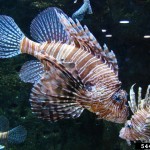
Lionfish (Pterois volitans):
Red Lionfish are a predatory reef fish that are non-native invasive species and have spread throughout Florida Waters. They are members of the family Scorpaenidae whose members are venomous and the lionfish is no exception. This fish is relatively small ranging from 10-12 inches in length and have a zebra-like appearance with long, showy pectoral fins. They have a row of long dorsal spines that contain venom glands. Their native range is the South Pacific and Indian Oceans and preferred habitat is on offshore reef structures. These fish are considered to be voracious eaters feeding on native fish, reducing vital native populations, and competing for food with native fish such as grouper and snapper.
With few predators, these fish are thriving in Florida waters, even in the northern Gulf of Mexico. They reproduce often, under good conditions as often as every 3-4 days, with eggs hatching after about two days. They also consume a variety of local species. Research has found in some cases there has been an 80% decline in reef fish recruitment and loss of some economically important species. These fish are able to expand their stomachs for large meals and can survive starvation for over 12 weeks. Lionfish are an invasive species in our local waters and removal is encouraged.
The most effective control of this species is removal by spearfishing; though some recent reports of hook and line capture using live bait have occurred. Lionfish are cryptic and nocturnal but local divers have found them hovering near reefs at midday. Florida Fish and Wildlife Conservation Commission (FWC) changed regulations to increase harvesting opportunities. Such changes include no requirement for a recreational fishing license when using spearing devices (pole spear, a Hawaiian Sling, handheld net, or spearing devices marked for use on lionfish), and no recreational or commercial bag limit; though recreational fishing license is required for other fishing methods. Check the FWC regulations before fishing or diving for these species.
Lionfish are venomous, must be handled carefully, venom glands occur on the dorsal, pelvic and anal spines. Lionfish sightings can be reported at 877.786.7267, the newly released FWC lionfish app,or (if in the Pensacola area) the lionfish map. If stung the wound can be treated with warm (but not scalding) water. You may need to seek medical attention as soon as possible. Rarely are stings fatal unless the person has an allergic reaction. The Poison Help Hotline can be reached at 800.222.1222. Inshore sighting information is being collected by Florida Sea Grant in Escambia County to track the movement of these species. You can fill out the online report on the USGS website or the REEF website and stay up to date on research as it pertains to this species at the new NOAA lionfish portal and Florida Sea Grant.
For more information contact the author Rick O’Connor, UF/IFAS Escambia County Extension – Sea Grant and Marine Science Extension Agent, 850-475-5230.
Air Potato (Dioscorea bulbifera):
Air potato is a tall climbing herbaceous plant that is in the yam family and can overtake natural and urban areas in a very short time. Air Potato uses twining tendrils that allow it to quickly climb over shrubs, trees, and man-made structures. The large heart-shaped leaves and potato looking “bulbils” that hang from the vine make identification fairly easy. The bulbils spread the growth of the plant, along with underground tubers. The plant will die back during the winter, but unless the vines, bulbils and underground tubers are removed, it will come back in the spring. The air potato is native to Asia and was introduced in Florida in the 1905. The potato is not good to eat and in some cases, may be poisonous.
There are a number of ways to control this species, and using a combination of methods may lead to greater success. Eliminating the vines and bulbils by collecting them, be sure to dispose of them where they will not be spread to other areas. The bulbils and underground tubers cannot survive freezing temperatures, so placing them in a freezer for a day and then disposing of them will help eliminate new growth.
Some cites in Florida have sponsored activities that involve the community in gathering air potato and other invasive species. Collecting the bulbils and underground tubers is easiest to do during the winter, when the green vegetation has dies back.
Herbicide treatments are best when applied during the late part of the growing season when plants are sending carbohydrates to the root system this is usually August through October. Wait as late as possible but before the leaves start turning yellow to apply. Yearly treatments may be needed to eventually eliminate the plant entirely. Apply herbicides according to the label on the herbicide container and apply with caution as not to spray other plants. For more information on types and strengths of herbicides to use in the fight against air potato, click here. If you have questions on using herbicides contact your local county extension office.
Biological controls are being tested in v
arious parts of Florida using a beetle that was found to dine on air potato vegetation and tubers at different life stages. For more information on biological controls, click here.
Click here for an identification card for the air potato. For more information contact the author Chris Verlide, UF/IFAS Santa Rosa County Extension – Sea Grant Extension Agent, 850-623-3868.

Air Potato can spread quickly along the ground and into trees. Photo by Julie McConnell (click for larger image)
Posted: February 25, 2015
Category: Invasive Species, Natural Resources
Tags: February, Invasive, Lionfish, Panhandle Outdoors, Potato, Species
![NISAW-logo09[1]](http://nwdistrict.ifas.ufl.edu/nat/files/2014/02/NISAW-logo091-300x119.jpg)



